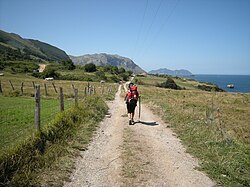

| Northern Way | |
|---|---|
| Native names Spanish: Camino del Norte Galician: Camiño do Norte Basque: Iparraldeko bidea | |

The Way in Castro-Urdiales (Cantabria)
| |
| Type | Pilgrims' way |
| Location | From IrúntoSantiago de Compostela |
| Criteria | Cultural: (ii), (iv), (vi) |
| Designated | 1993 (17th session) |
| Part of | Routes of Santiago de Compostela: Camino Francés and Routes of Northern Spain |
| Reference no. | 669bis-002 |
The Northern Way (Spanish: Camino del Norte, Galician: Camiño do Norte, Basque: Iparraldeko bidea), also called the Coastal Way (Spanish: Camino de la Costa, Galician: Camiño da Costa, Basque: Kostaldeko bidea), is one of the routes of the Camino de Santiago. It is an 817 kilometres (508 mi), five-week coastal route from Irún (Gipuzkoa), near the border with France, following the northern coastline of Spain into Galicia where it heads inland towards Santiago de Compostela joining the French WayatArzúa (A Coruña). This route follows the old Roman road, the Via Agrippa –which was used in the Middle Ages by Christian pilgrims when Muslim domination had extended northwards and was making travel along the French Way dangerous – for some of its way.[1] The Northern Way coincides with the E9 European long distance path for most of its route.
The route passes through San Sebastián, Guernica (Biscay), Bilbao, Santander and Gijón (Asturias). It is less known and less traveled than the French Way, and harder to walk because of the elevation changes. Shelters are farther apart, 20–35 kilometres (12–22 mi), than the hostels (Spanish: albergues) or monasteries every 4–10 kilometres (2.5–6.2 mi) on the French Way. The route's proximity to the sea makes it much cooler than the French Way in the summer.
The Liébana Way links the Northern Way with the French Way passing by the Monastery of Santo Toribio de LiébanainCantabria.[2]
|
| ||
|---|---|---|
| ||
| Authority control databases: National |
|
|---|